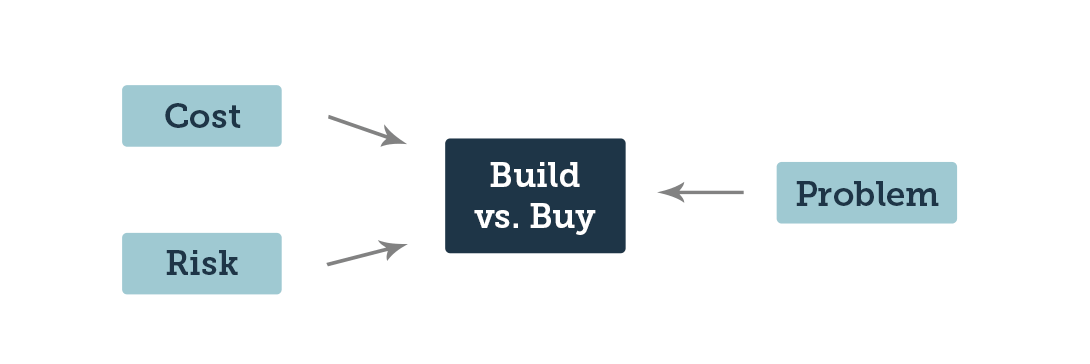To Build, or to Buy Enterprise Software: That is the Question
As organizations undergo rapid digital transformation, software solutions are largely being considered to help create efficiencies. In fact, The Gartner Worldwide IT Spending Forecast predicts that companies will have spend an estimated $503 billion on enterprise software in 2020, up 10.5% from 2019. When exploring the ways enterprise software can help an organization achieve its objectives, the question of whether to build it or buy it is one of the first and most challenging for many.
Companies often hit a paralyzing roadblock when weighing the pro and cons to building versus buying, encountering long-term consequences if the wrong path is chosen. As a growing enterprise-SaaS solution for education and training organizations, BenchPrep is constantly helping customers define the best solution for an effective and scalable digital transformation.
We are often asked about the benefits of buying, and, based on numerous consultations, we believe that choosing the right online solutions can generate a high return on your investment, often reducing costs for your business, while also avoiding constraints on valuable resources. Of course, a thorough internal assessment of your objectives, resources, and ultimate goals is an important part of evaluating your options.
To help navigate this complex decision-making process, we’ve compiled a list of common considerations and resources for you to better understand the build versus buy debate.
Identify the problem that needs to be solved
Often times, companies decide to build their own software in an effort to solve too many problems at once. Concerned that a third-party solution won’t meet their specific and customized needs, they develop an in-house platform, attempting to check the box for several issues. More often than not, this often results in an overly-complicated program that is too difficult to build or use. In fact, according to SAP, 78% of owned enterprise apps are abandoned due to lack of resources and time.
This scenario also creates a convoluted perspective on the problem an organization is actually looking to solve. Pinpointing a specific objective as to why software is needed in the first place is key, and 99% of the time, there’s already a software readily available to help solve the problem at hand. Leveraging a third-party enterprise software solution to improve a defined business need will allow your organization to effectively do so, allowing time to prioritize and allocate resources for other important business operations. 
Calculate the total cost of ownership
The total cost of ownership is one of the most important considerations when deciding to build versus buy. The true cost of building, maintaining, and operating a long-term software solution can be tricky to calculate. In-house solution costs are rarely predictable and often result in greater expenses than expected. According to a McKinsey survey of IT executives, large IT projects run over budget 45% of the time, while delivering 56% less value than planned. These high cost overruns can lead to project abandonment and internal dispute over how to solve the problem at hand.
When exploring options to buy a software solution, an initial cost may cause sticker shock for some, but the cost benefits of working with an expert third-party are high. When the cost is given up front, it provides your organization and decision making committee with transparent information for budget and resource discussions.
Understand the stakes
In a world of open-source development and 99-cent consumer apps, it can be difficult to understand the value and benefits that enterprise-level software offers. Building a powerful enough software solution for enterprise typically takes years of work and expertise.
When an organization does take the leap to take on a development project, chances are, third-party solutions who specialize in building software are already ahead of the game. Even before writing a line of code, it’s important to consider the long-term resource investment. In-house development requires continuous iteration, testing, training, monitoring, and many other technical updates in order to stay relevant and sticky.
Based on his first-hand experience of founding BenchPrep and taking its product from a consumer app initially to enterprise-level technology now, COO Ujjwal Gupta lends some helpful advice on how to evaluate the complex enterprise software market and the advantages to doing it the right way.
Turn to the experts
Particularly for our customers, organizations are quickly realizing the need to look beyond traditional learning management systems of the past for their education and training needs. While an in-house LMS once allowed organizations to store and manage content, learners today demand a more engaging and efficient learning experience. In order to provide a comprehensive, adaptive, data-driven, scalable learning platform, extensive technical acumen and ongoing support is required.
 As an established publisher in the market, McGraw-Hill Education faced the challenge of whether to build or buy a solution to best serve the needs of their customers. They realized an urgency to reassess the delivery of their content to stay current and relevant in a market that was quickly moving away from traditional learning methods and toward digital delivery.
As an established publisher in the market, McGraw-Hill Education faced the challenge of whether to build or buy a solution to best serve the needs of their customers. They realized an urgency to reassess the delivery of their content to stay current and relevant in a market that was quickly moving away from traditional learning methods and toward digital delivery.
Read the full case study to learn about the benefits and results as a result of turning to BenchPrep to lead their digital transformation.






